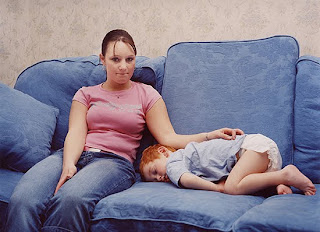August Sander was a German portrait photographer and has been described as "the most important German portrait photographer of the early twentieth century." His most famous work was that of People of the 20th Century, in which he photographed people posed in ways that reflected their career/status.
A few examples:

His photo's are highly staged/posed/directed and quite obvious in their content but they do portray a certain truth of society at the time.
Diane Arbus
Arbus is known for her black and white square imagery of those on the fringes of society, or minorities that appear aesthetically surreal or ugly. Her work was often described as presenting a modern day freak show as she included dwarfs, giants, transgender, prostitutes etc.
She documented “Things that nobody would see.” unless she photographed them. Her interest is with The Other and therefore she is likely to represent her subjects in certain ways that would be more shocking, or of more interest to the viewer. E.G. Flash = Dramatic/Theatrical/Performed – almost like circus “freaks” “The square format of her images suggested a voyeurism and immediacy often associated with the polaroid format...” Clarke, The Photograph P.22 Arbus presents “the careful plotting of psychological states of mind.” Clarke, The Photograph p.194
There have been debates surrounding the ethics of her work. For example she was said to have tormented the young boy below holding the grenade, and in this TIME magazine article Richard Lacayo posits that “Arbus, especially, did not take much of an interest in the people in her pictures for themselves. What she cared about was how they could function as emblems of the various beasts within us.” Photography: American Beauty, Richard Lacayo, TIME magazine
Nan Goldin
Nan Goldin is a modern American Photographer (70's - 00's) Her work was often concerned with her close family and friends, particularly focusing on gay culture, and she often portrayed controversial themes such as domestic abuse and aids. Her work is largely 'loosely thematic' and portrays a whole range of situations and personal spheres. A lot of it is often censored as it is sexually explicit and she has been criticised for such things as glorifying drug use.
Tina Barney (born 1945, New York City) is an American artist photographer best known for her large-scale, color portraits of her family and close friends, many of whom are from the upper class societies of New York and New England.
Tina Barney has said, “I began photographing what I knew.” For much of the 1980s and 1990s, this meant taking pictures of her friends and family as they went about their daily lives in affluent areas of Long Island, New York City, and New England. Employing a large-format, 8-by-10-view camera enabled her to create highly detailed images that retain their focus and richness even when made into four-by-five-foot prints. Barney was thus one of the first photographers to present color work on a grand scale that rivaled most twentieth-century paintings. This scale also inspired a deliberate construction of the picture, at times requiring supplementary lighting and the direction of the sitters.
(section from the art Institution of Chicago)
Fazal Sheikh
Fazal Sheikh is an American photographer who depicts "the lives of individuals in displaced communities across East Africa, in Pakistan, Afghanistan, Brazil, Cuba and India." (Fazal Sheikh Website) He has a concern with human rights which can be seen in his photographs as many of his subjects adopt the non-western, intra-diegetic gaze in which they stare out at the viewer thereby communicating with them.
"In 2001 he established a series of projects and books about international human rights issues that would be published and distributed free of charge and made available online. These are published under the imprint of the International Human Rights Series " (Fazal Sheikh Website)
He uses a small depth of field and really focuses on the eyes of the person as if they're staring into the soul, and urging you to help them.
Michelle Sank
















































